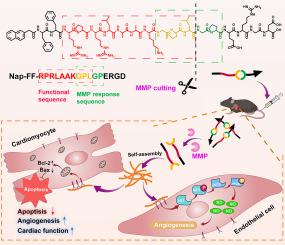当前位置:
X-MOL 学术
›
J. Control. Release
›
论文详情
Our official English website, www.x-mol.net, welcomes your feedback! (Note: you will need to create a separate account there.)
Adaptive enzyme-responsive self-assembling multivalent apelin ligands for targeted myocardial infarction therapy
Journal of Controlled Release ( IF 10.5 ) Pub Date : 2024-06-29 , DOI: 10.1016/j.jconrel.2024.06.033 Jiejing Li 1 , Xudong Song 1 , Xu Liao 1 , Yihan Shi 1 , Huiming Chen 1 , Qiuqun Xiao 2 , Fengjiao Liu 1 , Jie Zhan 3 , Yanbin Cai 4
Journal of Controlled Release ( IF 10.5 ) Pub Date : 2024-06-29 , DOI: 10.1016/j.jconrel.2024.06.033 Jiejing Li 1 , Xudong Song 1 , Xu Liao 1 , Yihan Shi 1 , Huiming Chen 1 , Qiuqun Xiao 2 , Fengjiao Liu 1 , Jie Zhan 3 , Yanbin Cai 4
Affiliation

|
Microvascular dysfunction following myocardial infarction exacerbates coronary flow obstruction and impairs the preservation of ventricular function. The apelinergic system, known for its pleiotropic effects on improving vascular function and repairing ischemic myocardium, has emerged as a promising therapeutic target for myocardial infarction. Despite its potential, the natural apelin peptide has an extremely short circulating half-life. Current apelin analogs have limited receptor binding efficacy and poor targeting, which restricts their clinical applications. In this study, we utilized an enzyme-responsive peptide self-assembly technique to develop an enzyme-responsive small molecule peptide that adapts to the expression levels of matrix metalloproteinases in myocardial infarction lesions. This peptide is engineered to respond to the high concentration of matrix metalloproteinases in the lesion area, allowing for precise and abundant presentation of the apelin motif. The changes in hydrophobicity allow the apelin motif to self-assemble into a supramolecular multivalent peptide ligand-SAMP. This self-assembly behavior not only prolongs the residence time of apelin in the myocardial infarction lesion but also enhances the receptor-ligand interaction through increased receptor binding affinity due to multivalency. Studies have demonstrated that SAMP significantly promotes angiogenesis after ischemia, reduces cardiomyocyte apoptosis, and improves cardiac function. This novel therapeutic strategy offers a new approach to restoring coronary microvascular function and improving damaged myocardium after myocardial infarction.
中文翻译:

用于靶向心肌梗死治疗的自适应酶响应自组装多价 apelin 配体
心肌梗塞后的微血管功能障碍会加剧冠状动脉血流阻塞并损害心室功能的保存。肾上腺能系统以其对改善血管功能和修复缺血心肌的多效作用而闻名,已成为心肌梗死的有前途的治疗靶点。尽管天然 apelin 肽具有潜力,但其循环半衰期极短。目前的apelin类似物的受体结合功效有限且靶向性差,限制了其临床应用。在本研究中,我们利用酶响应肽自组装技术开发了一种适应心肌梗死病灶中基质金属蛋白酶表达水平的酶响应小分子肽。该肽经过工程改造,可响应病变区域高浓度的基质金属蛋白酶,从而实现 apelin 基序的精确和丰富的呈现。疏水性的变化使得apelin基序能够自组装成超分子多价肽配体-SAMP。这种自组装行为不仅延长了apelin在心肌梗塞病灶中的停留时间,而且由于多价性而增加了受体结合亲和力,从而增强了受体-配体相互作用。研究表明,SAMP可显着促进缺血后血管生成,减少心肌细胞凋亡,改善心功能。这种新颖的治疗策略为心肌梗死后恢复冠状动脉微血管功能、改善受损心肌提供了新途径。
更新日期:2024-06-29
中文翻译:

用于靶向心肌梗死治疗的自适应酶响应自组装多价 apelin 配体
心肌梗塞后的微血管功能障碍会加剧冠状动脉血流阻塞并损害心室功能的保存。肾上腺能系统以其对改善血管功能和修复缺血心肌的多效作用而闻名,已成为心肌梗死的有前途的治疗靶点。尽管天然 apelin 肽具有潜力,但其循环半衰期极短。目前的apelin类似物的受体结合功效有限且靶向性差,限制了其临床应用。在本研究中,我们利用酶响应肽自组装技术开发了一种适应心肌梗死病灶中基质金属蛋白酶表达水平的酶响应小分子肽。该肽经过工程改造,可响应病变区域高浓度的基质金属蛋白酶,从而实现 apelin 基序的精确和丰富的呈现。疏水性的变化使得apelin基序能够自组装成超分子多价肽配体-SAMP。这种自组装行为不仅延长了apelin在心肌梗塞病灶中的停留时间,而且由于多价性而增加了受体结合亲和力,从而增强了受体-配体相互作用。研究表明,SAMP可显着促进缺血后血管生成,减少心肌细胞凋亡,改善心功能。这种新颖的治疗策略为心肌梗死后恢复冠状动脉微血管功能、改善受损心肌提供了新途径。
















































 京公网安备 11010802027423号
京公网安备 11010802027423号